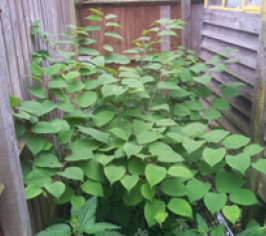Japanese knotweed, also known as Fallopia japonica, is an invasive plant that spreads rapidly and crowds out other native vegetation. It can grow almost anywhere, including gardens, parks, and roadsides.
This aggressive plant can cause significant damage, including
- Loss of native plant species
- Structural damage
- Land value reduction
- Mortgage difficulties
Recognising Japanese knotweed
Here are key features to help identify Japanese knotweed:
- Large, green, shovel-shaped leaves
Japanese knotweed leaves are distinctively large and shaped like shovels. They are typically 10-15 centimetres long and have a smooth, glossy surface.
- Vertical bamboo-like stems
The plant's stems are hollow and can grow up to 3 meters tall. They are typically green but may turn red or purple in autumn.
- White flowers
Japanese knotweed produces white flowers in late summer or early autumn. The flowers form small clusters along the stems.

Controlling Japanese knotweed
Controlling Japanese knotweed can be challenging as it is an invasive species of plant which spreads rapidly and overwhelms other plants. It is crucial to prevent the plant from spreading to other areas.
Landowner responsibility
The landowner is responsible for controlling Japanese knotweed on their property. This includes preventing the plant from spreading to neighbouring lands or public spaces.
Consult landowners
If you find Japanese knotweed on private land, such as a neighbour's property or a construction site, contact the landowner first. If no action is taken, report the issue to the Environmental Health department.
Public or council-owned land
For Japanese knotweed on public or council-owned land, contact the Environmental Sustainability Service.
Proper disposal
Do not remove or dispose of Japanese knotweed on your own, putting it in your bin or local waste centre is an offence. Contact a specialist contractor for proper removal and disposal.
Intentionally spreading Japanese knotweed is an offence. Improper disposal of the plant can also lead to legal consequences.
More information
For more information on Japanese knotweed, including identification, control methods, and legal obligations, visit Gov.uk.
Contact
Environmental Health
Telephone
0151 443 4712
environmentalhealth@knowsley.gov.uk